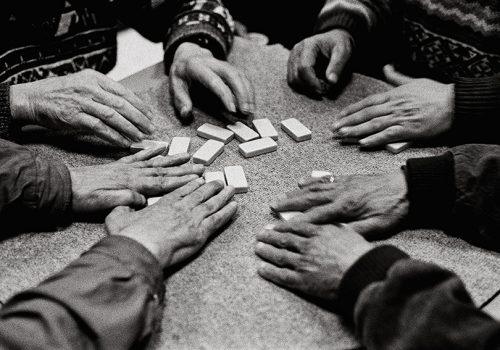These men could have been cousins, friends of the village, or my father’s colleagues.
As a child, they were an integral part of my family environment. My parents regularly welcomed them. It was an invaluable support for their compatriots: the “zoufris” (workers) who, unlike them, suffered the full force of the loneliness of exile. I remember that their bodies and the expression of their faces expressed all the austerity of a daily life, chained to the rhythm of a factory or a construction site. They were transformed in contact with our home, which was noisy with children. Relaxed, with a hot mint tea, sitting around the living room table, they played endless games of dominoes. In this warm atmosphere, they exchanged experiences, supported each other, advised each other. They spoke the Algerian dialect, a language that we children did not understand. Sometimes, a word or a French expression escaped from their exchanges, punctuated by loud bursts of laughter, one guessed by the sound of their voices and the expressiveness of their gestures that they evoked their condition of life in France or missing the country and the family. Meanwhile, my mother solemnly prepared couscous for dinner. In the background, a song by Oum Khalthoum accompanied these nostalgic moments when an indescribable feeling of melancholy pierced your heart.
These men immigrated to France during the “30 Glorieuses”, when French industrial enterprises in need of manpower appealed to the natives of the Maghreb and sub-Saharan Africa.
These young workers represented an abundant, inexpensive and laborious workforce, mostly from rural areas.
As an adult, I saw their discreet silhouette in public space, they had reached retirement age and remained invisible and cut off from a society that they had nevertheless helped to build and develop.
Let us remember the bitter awakenings of the 80s and 90s, marked with the emergence of immigrant struggles and the demands of young people from immigrant backgrounds like “The March for Equality and Against Racism” and the emerging associative movement.
Let us remember in 1999, the national euphoria due to the final of the 1998 Football World Cup won by Zinedine Zidane and his team, and before September 11, 2001.
It was then that I decided to begin this photographic work, like the thread of a quest for identity that went on for almost 20 years.While traveling through the city of Marseille, I often stopped in the Belsunce district, attracted by the atmosphere of the”Thieves Market” installed illegally on the Place d’Aix, where ragpickers sold all kinds of small goods on the ground. The place was especially appreciated by the “chibanis” (the elders) who came to kill time. The majority of them strolled through the displays as in a museum, others sat around, watching the animation under the rays of the sun, others still in need, sold with dignity odds and ends for a few cents .
From there, was born this irrepressible desire to photograph them.
To complete the portraits, it seemed to me necessary to collect their word: their personalities aroused my curiosity about what they had been able to live as men in a foreign land whose mores and customs were different from their country of origin.
I wanted to know their life experiences and collect their testimonies, knowing that the majority of them were illiterate and from a peasant background.
Many are those whose Odyssey began in the Phocaean city, obligatory passage and symbolic passage of the migratory history. Some stayed there, others went to other industrial or mining cities to earn their bread by the strength of their arms, their backs and their courage.
Through “these Ulysses”, I have been able to engrave the memory of our elders and thus pay tribute to these men and to all the migratory waves that have marked and still mark the history of this country in all its diversity.
Leïla Bousnina
Photographer, born in 1969, Leïla Bousnina is from Seine-Saint-Denis.
In 1991, while pursuing studies in art history, audio-visual option, she integrated for five years a sociological structure of studies and observations on the suburbs “Banlieuescopies”, which led her to photography , specializing in socially dominant subjects.
In 2000, she undertook the photographic work of “Ulysses”: to photograph and collect the life stories of elderly immigrant men: the former workers who came en masse to France during the “30 glorious days”, which we now call the Chibanis, with the aim of gathering this work in a book: “Ulysses”, Editions Otium in December 2018.
“I mainly worked in a school or in socio-cultural environment as a photographer or as an educational workshop leader. »Leïla Bousnina
The association Pour Que l’Esprit Vive
The FAIT & CAUSE gallery and the SOPHOT site
present
Leïla Bousnina: Ulysses
from Wednesday January 15 to Saturday February 29, 2020
FAIT & CAUSE Gallery
58 rue Quincampoix
75004 Paris
Opening hours: Tuesday to Saturday, 1:30 p.m. to 6:30 p.m.
Book:
Ulysses
Photographs and texts – Leïla Bousnina
Illustrations – Kamel Khélif
Otium editions 2018
















